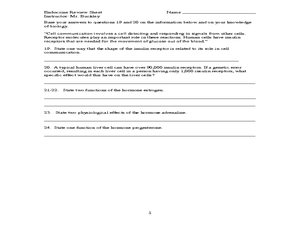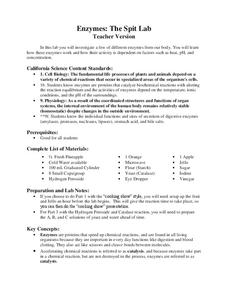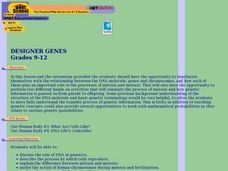National Institute of Open Schooling
Atomic Structure
Learners explain historical findings such as Rutherford and Bohr's contributions, explain wave particle duality, and formulate Heinsenberg's uncertainty principle. They also draw s, p, and d orbitals, explain more historical findings,...
Serendip
Photosynthesis and Cellular Respiration
How does energy from the sun make plants grow? Scholars move step by step through the processes that promote plant propagation during a detailed lesson. The resource illustrates ADP production and hydrolysis, then allows learners to...
Curated OER
Chapter 14 Review, Section 2: Acids and Bases
Lewis acids and bases, Brønsted-Lowry acids and bases, ionization, and more are covered by this chemistry handout. It serves as a review of a specific textbook section, but will also serve as a nice review for any general chemistry...
NASA
Making Oxygen and Carbon Dioxide
Some like it hot! Scholars observe both exothermic and endothermic reactions as part of the carbon dioxide oxygen cycle. First, scientists demonstrate (or watch) a chemical reaction to create pure oxygen using fire for confirmation....
National Institute of Open Schooling
Nomenclature and General Principles
Carbon, the base for all organic compounds, exists in nature in its purest form as graphite or diamonds. The 25th lesson in a series of 36 teaches pupils the nomenclature of organic compounds. Learners read about how to use the IUPAC...
Curated OER
Endocrine Review Sheet
Starting with a diagram of the kidneys and urinary tract of the human, this sheet has questions about excretion, blood concentrations of hormones, gland feedback mechanisms and the effects of some hormones.
Curated OER
Organic Compounds
Your young biologists will find these slides very useful to help differentiate between the different nutritional components. The slides contain step by step details of the different levels of structure and function. These would be...
LABScI
Enzymes: The Spit Lab
Enzymes in our bodies each have a job to do. Learn the factors that affect the activity of some enzymes using the third activity of an informative 12-part biology series. A three-part laboratory activity asks teams to investigate how...
Biology Junction
Energy Flow in an Ecosystem
Every living thing requires a food source, thus the interconnections in ecosystems become complex. Scholars learn about these interconnections in a presentation on energy flow. It starts with the sun and moves through many different...
Curated OER
Physical and Chemical Properties of Water
High schoolers experiment with water as a component of suspensions, solutions, and heat conduction contributing to the use of food and the health and wellness of human beings.
Curated OER
How Many Drops?
Students conduct a simple test to determine how many drops of each of three liquids can be placed on a penny before spilling over. They come up with an explanation for their observations about different amounts of liquids a penny can hold.
Curated OER
The Chemistry of Life
In this chemistry of life activity, students will review key terms of plant cell structure and chemistry by reading 13 clues to complete the puzzle. Word bank is included.
Curated OER
DNA and RNA Exercises
In this protein synthesis worksheet, students answer 14 short answer questions about the process of making proteins from DNA.
Curated OER
DNA: What Does It Mean?
Tenth graders explore DNA using online tutorial. They perform their own DNA extraction from a clove of garlic and identify the key components of DNA.
Curated OER
DNA and Genes
In this DNA activity students will label the 6 parts that make up DNA and review the process of replication of DNA. This activity has 6 matching and 5 fill in the blank questions.
Curated OER
Modeling Protein Structure
Students examine amino acids and discuss the properties of side chains. In this proteins lesson students demonstrate the foldings of peptides.
Curated OER
Nucleic Acid
In this chromosome activity students complete a crossword puzzle by answering questions on DNA, nucleic acids, nucleotides and RNA.
Curated OER
Water - the (Nearly) Universal Solvent
In this solvent worksheet, students explore why water is considered a universal solvent. Students explore what can change dissolving rates. This worksheet has 8 matching, 3 short answer, 11 fill in the blank, and 4 problems to solve.
Curated OER
Surface Tension (Soap Boat)
Learners investigate the affect of soap and water temperature on surface tension.
Curated OER
Designer Genes
Students view a video on DNA. They discuss mitosis, meiosis and fertilization. They use strips of paper to simulate fertilization and analyze the genotype and phenotype of the combined chromosomes.
Curated OER
The Structure of DNA
Students will demonstrate knowledge of the structure of DNA by constructing simple models of DNA with materials given to them in class. They will also discover that some female scientists such as Rosalind Franklin have not been given...
Curated OER
Water Cycle Boogie
Learners explore the water cycle. They learn the "Water Cycle Boogie." Students create hats to represent the different parts of the cycle and learn hand motions to go with the words of the song. Learners practice singing the song and the...
Curated OER
Genetics DNA Replication
Young scholars explore DNA replication. Beginning with a teacher led discussion, students examine inherited information, genes, and Deoxyribose Nucleic Acid (DNA). As the teacher models the structures of DNA, tells about the...
Curated OER
DNA Vocabulary Review
In this DNA worksheet, learners review vocabulary words associated with DNA, DNA replication, and gene expression. This worksheet has 13 matching questions.

























